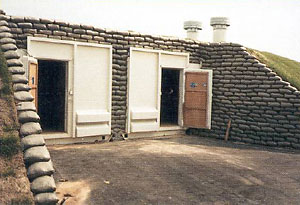What's in This Document
 |
Explosives Storage Magazine Types
Explosive materials that are not subject to the conditions in 27 CFR § 555.205 and that are not otherwise exempt pursuant to 27 CFR § 555.141 and 27 CFR § 555.32, must be stored in a magazine described below based on the class of explosive material. Refer to 27 CFR § 555.203.
Type 1 Magazine
Permanent magazines for the storage of high explosives. Other classes of explosive materials may also be stored in type 1 magazines. Must meet the construction requirements prescribed in 27 CFR § 555.207.
Type 2 Magazine
Mobile and portable indoor and outdoor magazines for the storage of high explosives. Other classes of explosive materials may also be stored in type 2 magazines. Must meet the construction requirements in 27 CFR § 555.208.
Type 2 Detonator Boxes must meet the construction requirements in 27 CFR § 555.208(c) and can only be used for the storage of up to 100 detonators.
Type 3 Magazine
Portable outdoor magazines for the temporary storage of high explosives while attended (for example, a “day-box”). Other classes of explosives materials may also be stored in type 3 magazines. Explosive materials cannot be left unattended in a type 3 magazine and must be removed to an appropriate magazine (i.e. type 1, type 2, type 4, type 5) for unattended storage. Must meet the construction requirements in 27 CFR § 555.209.
Type 4 Magazine
Magazines for the storage of low explosives. Detonators that will not mass detonate and blasting agents may also be stored in type 4 magazines. Must meet the construction requirements in 27 CFR § 555.210. Detonators that will not mass detonate can only stored with explosive materials listed in 27 CFR § 555.213(b)(1).
Type 5 Magazine
Magazines for the storage of blasting agents only. Must meet the construction requirements in 27 CFR § 555.211.
ATF Magazine-Related Rulings
ATF Ruling 75-21: Provides guidance on type 1 magazines with smooth finished concrete floors that were constructed under contract for use by the U.S. Department of Defense (DoD) or that meet or exceed the DoD construction specifications.
ATF Ruling 76-18: Provides bullet-resistant construction options for type 1 and type 2 magazines.
ATF Ruling 2004-3: Allows indoor type 4 magazines to be secured with flush mount bolt-style locks utilizing interlocking solid metal parts, each affixed securely to the magazine in such a way that they cannot be readily removed from the exterior of the magazine and each locking mechanism having at least five tumblers.
ATF Ruling 2007-3: Allows for the temporary storage of bulk blasting agents in type 5 mobile delivery vehicles provided certain conditions are met.
ATF Ruling 2010-7: Allows the storage of loaded perforating guns outside of locked magazines provided certain conditions are met.
ATF Ruling 2011-2: Allows for alternate locking methods for outdoor type 5 bins and silos containing bulk blasting agent.
ATF Ruling 2011-3: Allows for magazines to be secured with hidden-shackle “hockey puck” locks, recessed padlocks, and padlocks with boron alloy shackles.
ATF Ruling 2012-5: Allows the storage of explosive materials in type 4 magazines with wood-only floors, provided certain conditions are met.
ATF Ruling 2022-2: Allows the storage of explosive materials in remote avalanche control systems, provided certain conditions are met.

